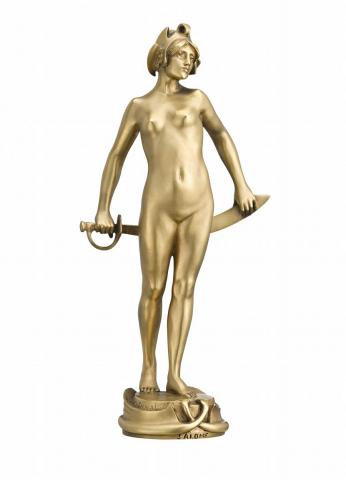SALOME, c.1895
Bertram Mackennal
Modelled in London
original edition of 20 cast by Gruet Foundry, Paris, 1896
bronze with gold patina
28.5 cm height
signed at base: B. MACKENNAL
inscribed at base: LONDON / SALOME
Private collection, London
Company collection, Melbourne
Bertram Mackennal: The Fifth Balnaves Sculpture Project, Art Gallery of New South Wales, Sydney, 17 August – 4 November 2007 (another example)
Edwards, D., Bertram Mackennal: The Fifth Balnaves Foundation Sculpture Project, Art Gallery of New South Wales, Sydney, 2007, pp. 5, 115 (illus., other examples), and catalogue raissoné in accompanying CD-ROM
Salome, c1895, gilt bronze, 29.0 cm height, Art Gallery of Western Australia, Perth
Salome, c1895, bronze, 29.0 cm height, Art Gallery of New South Wales, Sydney
A gilt bronze version of the present work is in the collection of the Art Gallery of Western Australia, Perth
During the 1890s Bertram Mackennal's mind was much occupied, along with the best of the Symbolists, with the femme fatales of his time and of past ages. While his several portrayals of Sarah Bernhardt, the living image of that mesmerisingly seductive woman included Bernhardt in the role of Cleopatra, and a bold bronze relief in the collection of the Art Gallery of New South Wales, his interest in the power of womanhood extended to include Eve and several versions of Queen Victoria. As noted elsewhere, Circe made her dramatic appearance, and he rounded off the decade with that marvellous marble bust of Dame Nellie Melba of 1899 now in the collection of the National Gallery of Victoria through the generosity of the diva herself. Salome, that tantalising strip-teaser from the Bible was a particular favourite in late nineteenth century Paris, epitomising the femme fatale of the past as Bernhardt did of the present. Gustave Moreau painted a number of famous versions, and friend and compatriot Rupert Bunny produced a colour monotype of Salome in 1898 showing the direct influence of Oscar Wilde's dramatic one act play Salomé. Wilde wrote his play in French in 1891. It was first published in that language in 1893, the English translation of the following year being illustrated with the sinuously brilliant drawings of Aubrey Beardsley. Obligingly, as if to add to the public interest in and promotion of Salome and Wilde's play, the 1892 rehearsals for its London debut were stopped by the Lord Chamberlain. Eventually it premiered in Paris in 1896.
The subject was ripe for exploitation and Mackennal responded, his bronze statuette being cast in Paris that same year. When translating the story of Salome into paint and print, artists usually confronted this stepdaughter of Herod Antipas with the decapitated head of John the Baptist. The delight of her mother Herodias was contrasted with the horror of Herod, who had unwisely offered to grant Salome's wish in reward for her dance of the seven veils. Mackennal, however, focused on the seductively naked body of Salome, the only reference to the beheading being the broad-bladed sword she holds behind. Its narrative reference is quite pointed.
DAVID THOMAS
